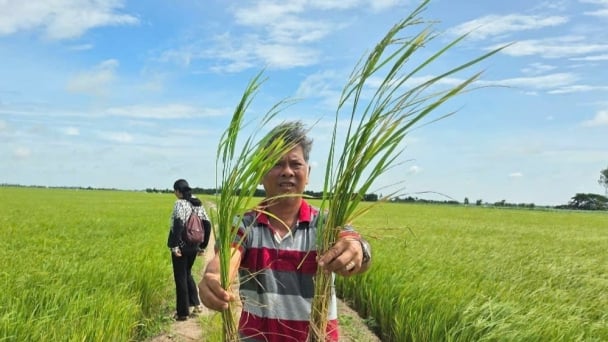September 1, 2025 | 06:40 GMT +7
September 1, 2025 | 06:40 GMT +7
Hotline: 0913.378.918
September 1, 2025 | 06:40 GMT +7
Hotline: 0913.378.918
With a long coastline, low-lying river deltas, and a tropical climate, Vietnam is on the frontline of climate threats. Extreme weather events, scorching heatwaves, devastating floods, powerful storms, and rising sea levels are no longer distant warnings but immediate challenges that threaten livelihoods and safety across the country.
Farms, factories, cities, and critical infrastructure face mounting risks of severe damage. Economic losses are already a reality rather than a potential hazard.

Tree planting activities in special-use forests across the country are being chosen by many businesses, contributing to creating a shield to prevent and combat natural disasters and ensuring sustainable development goals. Photo: Nguyen Thuy.
Tree planting in protected forests has become a strategy embraced by many businesses, serving both as a natural shield against disasters and as a step toward sustainable development.
A recent World Bank report, Vietnam 2045: Toward a Greener Future, underscores that inaction on environmental challenges could cost Vietnam at least 12.5% of its GDP by 2050.
Data from the General Department of Natural Disaster Prevention and Control, now the Department of Dyke Management and Natural Disaster Prevention under the Ministry of Agriculture and Environment show that in the past five years, storms in central Vietnam have grown stronger, with increasingly heavy rainfall triggering flash floods and landslides. The toll: nearly 400 dead or missing and economic losses reaching about USD 2.5 billion.
In 2023 alone, the country experienced 16 types of abnormal disasters, including more than 170 storms and heavy downpours, causing close to USD 40 million in damage. The following year, Super Typhoon Yagi struck northern Vietnam, inflicting a record loss of around USD 3.3 billion.
Looking ahead, 2025 raises further concern, with forecasts of more super typhoons, violent thunderstorms, flash floods, and landslides that could bring devastating consequences.
These threats are not unique to Vietnam. Across the world, climate shocks have escalated. In the past two decades, climate-related disasters have inflicted more than USD 3.6 trillion in damages globally. By 2050, climate migration could displace more than 216 million people.

Ms. Do Thi Thanh Huyen, Director of Gaia Nature Conservation Center (right) and sea beauty Ngo Bao Ngoc with leaders of Dong Nai Cultural Nature Reserve participate in tree planting. Photo: Nguyen Thuy.
Such figures are stark warnings. Experts stress that reducing risk requires concrete, localized actions such as reforestation, ecosystem restoration, and investment in green growth solutions.
At a recent tree-planting event, Do Thi Thanh Huyen, Director of Gaia Nature Conservation Center, joined with local leaders and Miss Sea Vietnam Bao Ngoc to highlight the importance of forests as natural defenses.
With more than 27 years in conservation, Huyen believes tree planting goes beyond safeguarding nature. It helps companies see tangible benefits in their sustainability journey. As global pressure mounts to meet Net Zero and ESG commitments, nature-based solutions are emerging as strategic pathways, especially for manufacturers. Yet, she noted, only 16% of companies worldwide have set targets linked to nature, and fewer than one-quarter of those are taking systematic action.
“Every minute, the world loses forest area equivalent to 10 football fields. Vietnam is among the seven countries most severely affected by climate change. Without action, the Mekong Delta could lose up to 40% of its land. How much longer can we afford to hesitate before standing with nature?” Huyen asked.
She explained that tree planting in landslide-prone or protective areas is one of the most durable ways to reduce disaster damage. Forests regulate water, shield soil from erosion, and serve as vast carbon sinks, while also preserving habitats that strengthen biodiversity, boost agricultural resilience, and improve food security.
“Planting forests not only restores ecosystems and absorbs carbon, but also sustains water resources, stabilizes climate, and enables companies to secure their positions in global value chains—where sustainability increasingly determines long-term survival”, Huyen emphasized, adding that Gaia will continue partnering with businesses to expand green cover across Vietnam’s nature reserves and special-use forests.
The World Bank recommends that Vietnam step up investments in climate adaptation, strengthen disaster-resilient infrastructure, and transition toward greener development models, including sustainable marine economies. Policy reforms should accelerate renewable energy, low-emission transport, and climate-smart agriculture, paving the way toward the nation’s goal of net-zero emissions by 2045.
Translated by Linh Linh
/2025/08/31/4433-3-134030_475.jpg)
(VAN) After 15 years of implementation, payments for forest environmental services have created a stable source of income, helping thousands of households and indigenous communities stick more with forests.
/2025/08/30/3629-3-183157_351.jpg)
(VAN) Prof. Dr. Phan Sy Ky, former Deputy Minister of Agriculture and Rural Development, affirmed, 'Never before has the irrigation sector had such a career and confidence as it does today.'
/2025/08/30/5239-5-024833_424.jpg)
(VAN) With the construction of the 'great canal' to channel freshwater and irrigation sluice and dike systems, the once acidic and alum-contaminated lands of Dong Thap Muoi and the Long Xuyen Quadrangle have revived.
/2025/08/29/5326-0-nongnghiep-105322.jpg)
(VAN) From a few hundred million USD in the late 1990s, Vietnam's wood exports have soared to USD 15 billion in 2025, affirming its status as a global powerhouse in wood processing and furniture manufacturing.

Instead of burning, microbial technology helps farmers turn millions of tons of straw into organic fertilizer, saving costs and protecting the environment.
/2025/08/28/5450-5-164042_320.jpg)
(VAN) From the risk of complete forest loss after the war, Vietnam has restored forest cover to more than 42%, becoming an international bright spot in forestry and sustainable development.